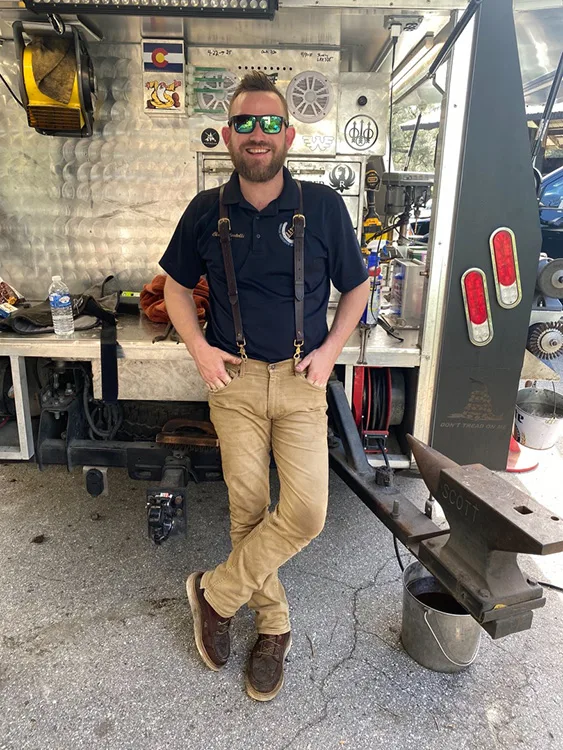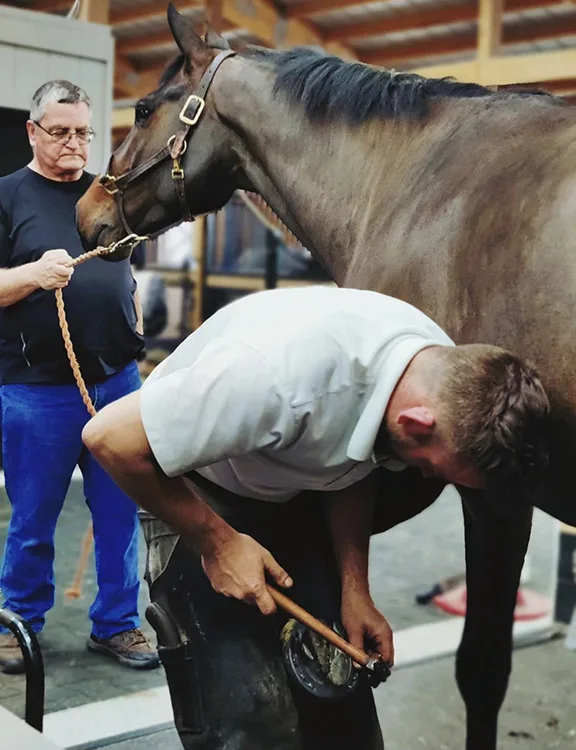When Team USA heads to Italy for the FEI Eventing World Championship next week, four of the equine athletes will share at least one thing in common: their farrier. While excited for the entire team, Ocala, Florida-based Chris Martelli of Fox Hill Forge will be cheering extra loudly for clients Off The Record and his direct reserve, Dondante, ridden by Will Coleman; Vermiculus, ridden by Lauren Nicholson, and Mai Baum, ridden by Tamie Smith, a horse he shoes when the pair is on the East Coast.
“These are my athletes,” says Martelli. “I see myself as a personal trainer for them, in the sense that the main reason—touch wood—they can move forward in their training so well is that I do my best to assist them in not missing a day. Once you miss a day, it turns into a week, and once you miss a week, you lose a month. Once you’ve lost a month, the season is gone, and the next thing you know, you literally lose the Olympics before you even had a shot to go.”

Chris Martelli shoes four horses who were named to the Land Rover U.S. Eventing Team headed to the FEI Eventing World Championship (Italy). Photos Courtesy Of Chris Martelli
Martelli has become one of the most sought-after farriers for elite event and jumper riders on the East Coast, carrying a book of nearly 300 clients including Buck Davidson, Hallie Coon, Zach Brandt and Sydney Elliott. But despite growing up in Lexington, Kentucky, and having a grandfather and uncle who both were partners at Hagyard-Davidson-McGee Associates (now Hagyard Equine Medical Institute), Martelli didn’t initially foresee a future with horses.
“I have probably ridden 12 times in my entire life, and I’ve been run off with twice,” says Martelli with a laugh. “I prefer a four-wheeler or dirt bike—it doesn’t colic, and I just feed it gas. My mother didn’t want us all in the horse world, I think because she saw what they went through at the clinic. I didn’t really touch a horse until I was in my 20s, when I was living in Colorado.”
But while living out West, Martelli first saw a World Championship Blacksmiths competition—and the arc of his life was forever changed. Fascinated by the competitors’ ability to shape straight raw steel and turn it into a finished product, Martelli reached out to Mitch Taylor, an American Farrier’s Association certified journeyman farrier and founder of the Kentucky Horseshoeing School in Richmond, Kentucky. Martelli started there in 2009, spending nine months in the classroom before completing two, year-long internships—one with Chris Beymer, farrier for 2022 Kentucky Derby winner Rich Strike, and another with Alan Frye.
Working under Beymer and Frye gave Martelli valuable hands-on experience with racing Thoroughbreds at all stages of their career, from yearlings to broodmares. Taylor even invited him to spend six weeks teaching at the Jockey Club of Turkey in Istanbul. After Martelli returned to Kentucky to complete his final exam— where World Champion farriers and veterinarians spent three days evaluating candidates’ practical skills, conducted written and oral tests, and reviewed their thesis—he graduated from the Kentucky Horseshoeing School with an accredited diploma in farriery science.
Upon earning his diploma, Martelli relocated to Ocala, where he spent five more years apprenticing under Thoroughbred specialist Bob Hodges.
“About 95% of what we did were Thoroughbreds in the 2-year-old and running market,” says Martelli. “I have gotten to do Derby horses, Belmont horses, Preakness horses, Breeder’s Cup horses.”
But despite the celebrity status of many of his equine clients, Martelli says he began to feel a bit like a “short-order cook.” Each horse was shod in a fairly similar way, and he knew that the tools he had gained during his education were not being fully utilized. On the side, he had picked up a few sport horse clients, one of whom was Australian show jumper Scott Keach. Keach began to recommend Martelli to other jumpers and eventers, and shortly after the 2016 Rio Olympics, Martelli left racing Thoroughbreds behind.
ADVERTISEMENT
“The switch was quite intentional,” says Martelli. “I’ve always liked eventing, and I had had enough of the Thoroughbreds. Having to shoe for three different disciplines, you are never bored. You are actually able to pay attention to what all can go into shoeing any specific horse.”
Martelli tries to keep a horse’s shoeing simple—plain steel shoes—adding pads and other adjustments only as needed. He also considers variables such as the horse’s living environment, the farm’s management style and even the type of bit the horse goes in when choosing how to size and set the shoe. But most importantly, Martelli believes that it requires collaboration among an elite equine athlete’s day-to-day caretakers, health professionals and trainers to ensure their success; he considers his role just one facet of the overall picture.
“We 100% work as a team,” says Martelli. “When you get into this level of horse, almost every one has had an injury at some point, or some type of setback, whether due to their age or what we ask of them. It’s a constant, maintenance-based relationship between the veterinarian, myself and the rider.
“We’re constantly on the phone, having back and forths,” Martelli continues. “I ask things like, ‘How would you like me to do this?’ or ‘What did you see the last time you were there?’ to the vet, or ‘How does it feel?’ to the rider. By no means are these horses just great, or the rider just great, or any blacksmith or vet just great. It is totally a community-based around these horses. With a group that has the common goal of the horse moving forward as the center spotlight of our practice—that is how these horses make progress.”
Collaboration is also essential for horses he works on only seasonally, such as Smith’s West Coast based mount Mai Baum. Martelli is committed to supporting the regular farrier’s vision.
“This is probably the hardest part,” says Martelli. “I don’t want to step on any toes or do anything differently, because I don’t know the back story. And if it’s right before they’re going to do something big—that’s where I just try to stay out of the horse’s way and don’t try to change everything.”
Martelli spends long days on the road—rarely finishing before 7 p.m. and sometimes working as late as 10. In addition, he makes it a priority to travel to all major East Coast FEI competitions—from Land Rover Kentucky to Great Meadow International (Virginia) to the Maryland 5 Star—simply to be on hand should one of his athletes need him.
“Normally by the time I get to a show, my goal is to sit in the truck the entire time and just be there, not in the way,” says Martelli. “But [I like] to give that peace of mind for my riders as they head into warm-up. They see my truck sitting there, and they know they can take a five [stride] and make it a four, and if something happens, I will be right there. The goal, though, is not to get out of the truck. We had 15 go through Kentucky last year and lost only one shoe!
“When I put this apparatus on the horse’s foot that they did not come out of the womb with, I owe it to them to be there,” Martelli continues. “As I said, they are my horses; they’re my athletes. I want to make sure everything is OK, and they don’t miss a single day.”
ADVERTISEMENT
Martelli’s success isn’t only due to his work ethic, experience and collaborative spirit—he also credits the unwavering support and understanding of his wife, Claire (Tisckos) Martelli, a former elite groom who handles Fox Hill Forge’s scheduling, billing and accounting. In late July they welcomed their son Callum, who attended his first upper-level event at Great Meadow International this August, at 4 weeks old.
“We drove all the way up from Ocala through the night and made it in 15 hours—he only cried for about 20 minutes when we got to Charlottesville [Virginia]—he did fantastic,” says Chris with a laugh. “It helps that Claire understands how much time is involved in my job, and she knows everybody in the horse world. Everywhere we go we kind of have built in babysitting. She is unbelievable—I couldn’t do it without her.”
Due to Callum’s young age, the family will not be traveling to Italy in support of the world championship this year. Instead, Chris will rely on updates from U.S. team farrier Kenny Bark, with whom Chris also enjoys an excellent working relationship.
“We are on the same page, and we have had multiple conversations about what direction I’m heading in with certain horses,” says Chris. “I send them with spares. At Aachen [Germany] this year, he was sending me cross-country starts via Skype. We are always in tune—that helps a lot.”
Despite the long days and intense demands, Chris thrives on the pressure and values his role in equestrian sport.
“My every day work is my competition, if that makes sense,” says Chris. “My competition is in the shed row. By the time they get out there, I hope to not see the horse until he has a ribbon on. You are never going to rid every variable from the game, but if I can deduct as many as possible, that moves us toward a better, safer and more proficient outcome, hopefully.
“It’s my life and my wife’s life, and I think that’s the only way you can get to this level,” Chris continues. “It is 24/7. From the day I put the shoes on until the day I change them out, I think about that horse every day. I think about every single one of them. Every. Single. Time.”
















